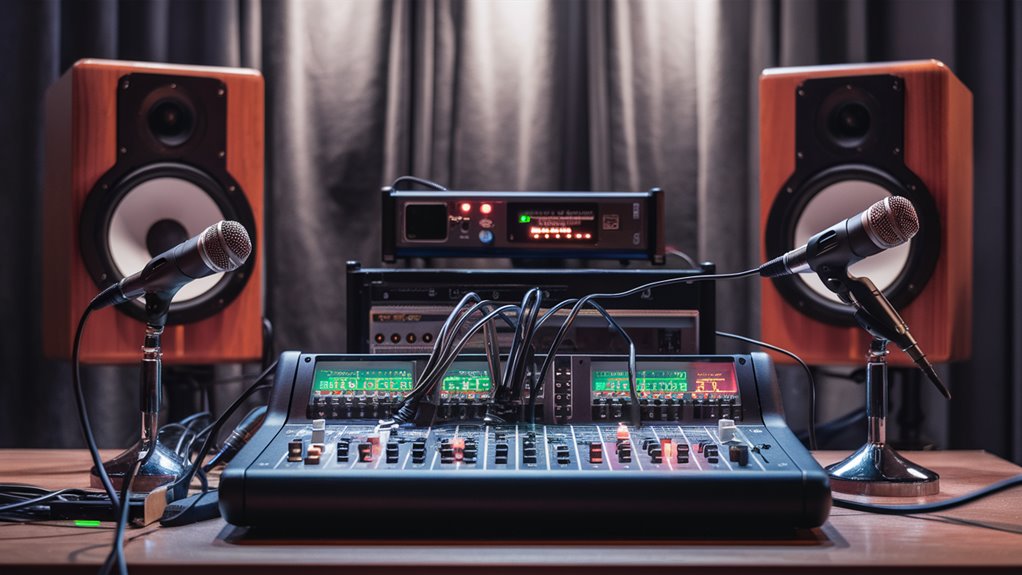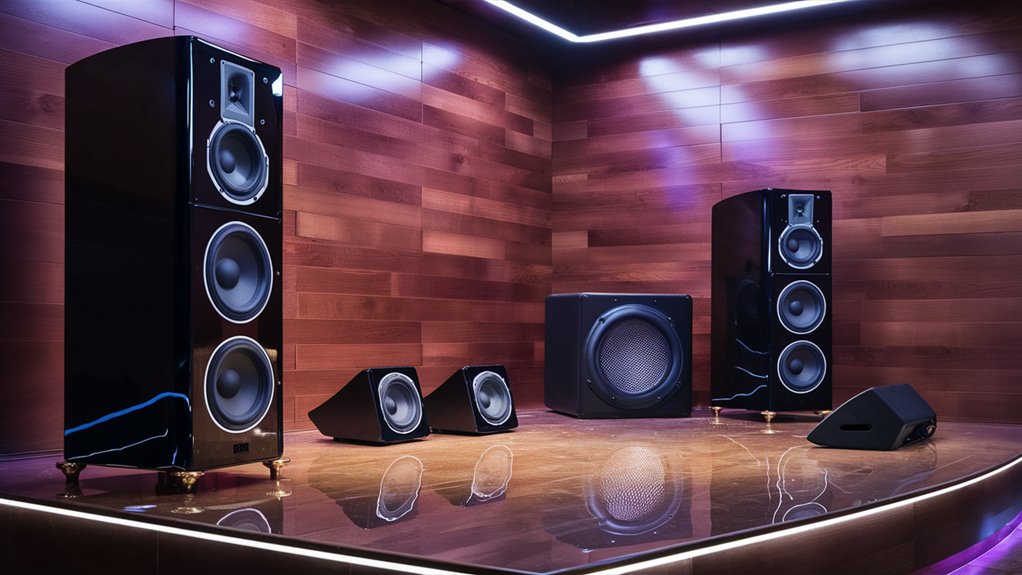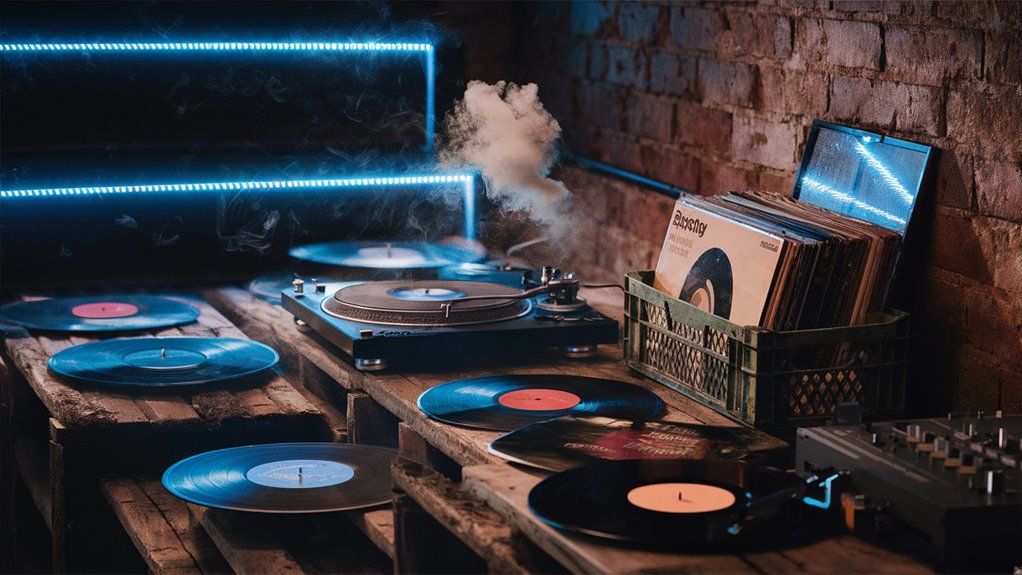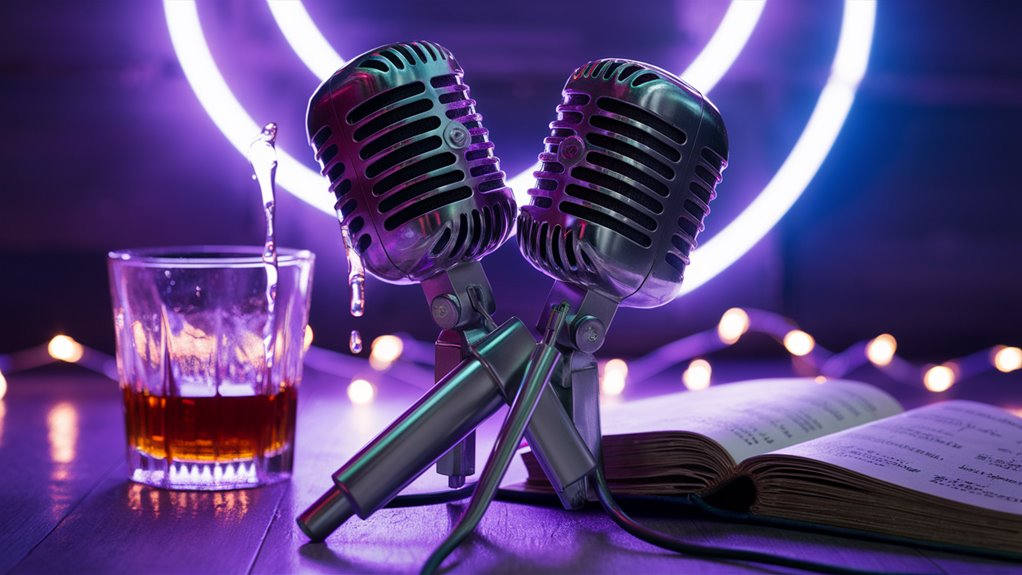Sound Gear: Making Karaoke Sound Great

Key Karaoke Sound Parts
To make the best karaoke set up, you need top sound gear that puts out very clear sound. A great karaoke system has five main parts:
- Digital Media Player that plays MP3+G files for good backing music
- 4-Channel Pro Mixer with EQ options
- Cardioid Dynamic Mics for great voice pick up
- Powered Speakers (300+ watts per channel)
- Audio Processor to handle effects
Best Way to Set Up Speakers
How you place speakers is key to good sound:
- Put speakers 5-6 feet up
- Set them at 45-degree angles for best sound spread
- Keep 6-8 feet between them
- Face them toward where you sing
Good Sound Connections
The cables used really affect the sound:
- Use balanced XLR connections for the whole system
- Get top shielding to stop other sounds from getting in
- Keep cables away from power sources
- Use extra grounding to cut noise
System Set Up and Sound
Putting these parts together well makes a pro karaoke place with:
- Even sound all over
- Clear voices in the mix
- Little feedback while singing
- Sound that fills the place
Key Parts of Karaoke Systems
A full karaoke system needs four main parts working well together for top quality show and fun.
Main Part #1: Karaoke Player and Source
The digital karaoke player is the brain of the system. It handles the music and words you see. Modern players handle many file types including MP3+G, MP4, and CDG. They have great features like playlist set up, song search, and key change while you sing, making sure things go smoothly during shows.
Main Part #2: Audio Mixer and Amp
Good karaoke mixers let you adjust sound perfectly, with own controls for each sound and settings to tweak sound. Key parts include:
- Voice effects
- Echo and reverb settings
- Many input options
- Main volume control
Main Part #3: Mic System
Good mics are a must for clear voice sound. Dynamic mics with cardioid setup offer:
- Less feedback
- Strong build
- Clear voice sound
- Less noise from holding them
Main Part #4: Speaker System
Good speakers finish the sound path, giving clear, strong sound. Powered speakers that have 300+ watts offer:
- All sounds clear
- Voices easy to hear
- Music sounds balanced
- Option to add more bass
System Set Up
Putting it all right needs good matching of parts thinking about:
- Power needs
- How parts connect
- Best path for the sound
- Setting it for the space
All parts must work together for the best karaoke fun.
Picking the Right Mics
Picking the Right Mics for Good Shows
Must Know Mic Details
Knowing mic details and how they work is key for the best voice sound. Three main things set mic quality and fit: frequency range, sound pick-up, and how much power they need.
Best Frequency and Pick-Up
The best frequency range for voice mics goes from 50Hz to 15kHz, catching all parts of the voice while keeping out low sound mess. Cardioid sound pick-up helps by really only catching sound from the front, cutting down on feedback and outside noise.
Knowing Power and Sensitivity
Low power mics (150-600 ohms) send sound well over long wires without losing quality. Mic sensitivity, shown in decibels (dB), is key. A sensitivity of -50dB to -54dB gives clear voice sound while keeping sound levels easy to handle.
Pro Dynamic Mic Choices
Dynamic mics like the Shure SM58 and Sennheiser e835 are great for live shows because they last long and handle loud sounds well. These top mics have built-in filters to keep sudden loud sounds smooth and make sure voices sound clear in live shows.
Mixers and Sound Tweaking
Pro Karaoke Mixer and Sound Tweaking Guide

Needed Mixer Parts
Pro karaoke setups need strong mixing and sound tweaking parts for the best sound. A high-function mixer should have at least four channels: two for mics, one for music, and one for special sound effects. Important features are separate control for each sound, EQ settings, and built-in digital effects like reverb and delay to make voices sound better.
Advanced Sound Tweaking
Smart sound control starts with the right compression and limiting. Set the compression start at -12dB with rates between 2:1 and 4:1 to keep voice sound natural. Feedback cut tech is a must, especially in small places, to 호치민퍼블릭가라오케 stop unwanted sound mess and keep sound clear.
Connections and Set Up
Pro mixers must have balanced XLR inputs for mics and RCA inputs and digital sound paths. USB links let them join well with new digital music systems and recording setups. Double output setup with main speaker outputs and special monitor lines make sure sound goes right all over. Fast processing is key for matching voice and music timing, giving a pro karaoke feel.
Power and Amp Needs
Sound Power and Amp Needs Guide
Know Power Output Needs
Choosing the right amp means knowing how much power you need based on how big the place is and how it sounds. The basic idea says 5-10 watts RMS per person for small places, and more like 10-20 watts for bigger places. Pro karaoke and shows often need 300-500 watts per channel at 8 ohms to keep sound dynamic and full Lighting and Sound
Speaker Sensitivity and Matching
Sensitivity of speakers, measured in dB/W/m, tells how well they use power. For best results, use speakers with a sensitivity of 90dB or more. Make sure to match the right amp power to the speakers to avoid damage and get the best sound.
Pro Set Up Choices
Dual-amp setups are best for pro sound systems. This way uses separate amps for main speakers and monitors, avoiding power mix-ups and giving clear control over what performers hear. Power units protect against power changes, giving stable, clean power for the best system work and long gear life.
Speaker Picking and Setting
Smart Speaker Picking and Setting for Karaoke Systems
Needed Speaker Set Up
Pro-grade karaoke systems need at least two speakers with 12-inch woofers and 1.5-inch tweeters for the right range of sound. For top results, pick speakers with 300 watts RMS per channel or more to handle loud voices and dynamic music.
Best Speaker Spots
Where you put speakers really matters for sound quality. Put speakers at ear level (5-6 feet) for best voice clarity. Place them at 45-degree angles facing in toward the middle of the room, keeping 6-8 feet apart. This setup gets the best sound sweet spot, letting performers hear themselves well while cutting unwanted feedback.
Set Up for Big Places
For better sound in big places, use monitor speakers tilting up toward where you perform, about 4 feet away. For places over 500 square feet, put in delay speakers in the middle for even sound all around. Make sure to set the right time delay matching 1 millisecond per foot from where the main sound comes from.
Sound Wires and Connections
Guide to Sound Cable Connections
Must-Have Sound Cables for Good Sound
Balanced XLR cables are must-haves in pro sound setups, cutting noise and keeping sound clear over long distances. These cables are great for places where sound quality is most important.
Types of Connections and Uses
Connect paths between mixers and amps must use either XLR or TRS (1/4-inch) cables. Ensuring connections are secure stops sound loss and keeps sound quality high. For mic setups, XLR cables are standard, providing grounding and the best mic-level sound moving.
Linking Consumer Devices and Digital Links
Hooking up normal sound sources needs good RCA cables or stereo 1/8-inch (3.5mm) to dual 1/4-inch adapters. Digital sound work needs special connections:
- Optical (TOSLINK) cables for digital sound moving
- Coaxial cables for digital sound ways
- DI (Direct Input) boxes for changing unbalanced signals to balanced ones
These pieces make sure different sound sources join well while keeping sound pro level.


